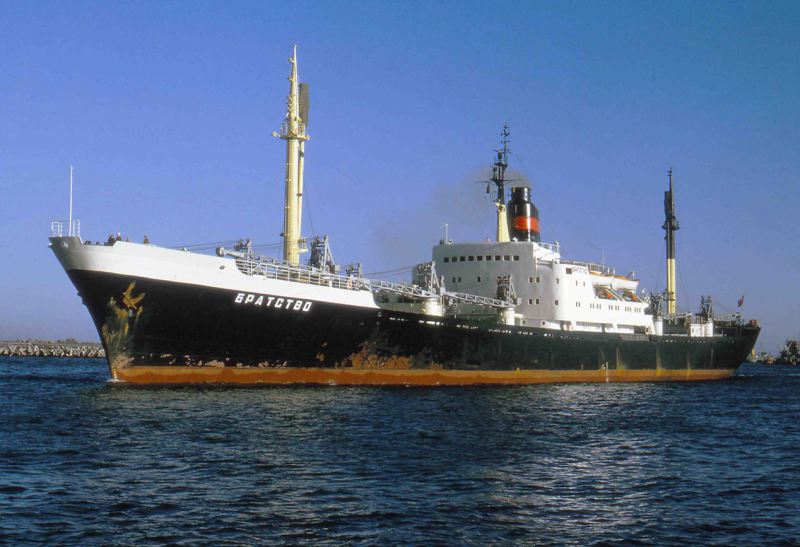The Soviet Union maintains amphibious forces at a high degree of readiness in all fleet areas. The main task in wartime is to secure the maritime flanks, outflank defending forces and secure beachheads for follow on regular army forces to exploit. It is unlikely that amphibious forces will be used for power projections as they would be in the west although amphibious ships have been very useful delivering equipment to Soviet allies and exerting a forward presence in trouble areas during peacetime.
Naval Infantry
Soviet Naval Infantry (NI) is a relatively light force meant for surprise and shock action. Unlike the US Marines, Soviet Naval Infantry will usually not use helicopter insertion to support an amphibious assault, instead that will be done by airborne troops and there is an airborne or air landing battalion integral to each NI Brigade (NI Regiments only have three NI Battalions). Each of the three western fleets has a NI Brigade, while the Pacific Fleet has a NI Division with an Air-Landing Regiment and two NI Regiments, one in cadre state but activated for Northern Fury:
55th NI Division at Vladivostok (Pacific Fleet)
63rd Guards Kirkenneskaya Brigade at Pechenga (Northern Fleet)
175th Brigade, at Tumanny in the North (independent but affiliated with Northern Fleet)
336th Guards Brigade at Baltiysk (Baltic Fleet)
810th Brigade, at Sevastopol (Black Sea Fleet)
From an equipment standpoint the NI has retired most of its PT-76 light tanks in favour of T-62 and T-72 MBTs but about 1,500 (of 12,000 produced) have been retained because of their ability to swim. Most BRT-60s have been replaced by BTR-80s.
One unique formation is 1st Fortified Area in the Vladivostok area, with five Machine Gun battalions and several fortified artillery and rocket launcher battalions.
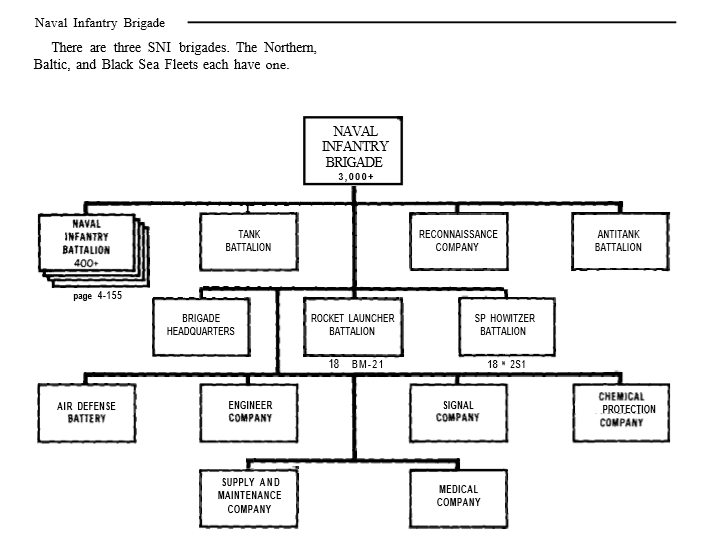
Ivan Rogov (Large Landing Ship)
The Ivan Rogov class or Project 1174 is the largest amphibious ship in the Soviet Navy. They have a bow ramp and a well deck enabling them to operate as an LST and land its cargo over the beach; or as an LPD in a stand off assault by dispatching helicopters and landing craft which exit from the stern dock and transport troops to the beach. Typically, four Ka-29 assault transport helicopters and various fully loaded landing craft are embarked but these can be replaced for extra cargo. The landing craft either three Gus Class (Project 1205) troop life hovercraft or two Lebed Class (Project 1206) air cushion vessels and a Ondatra Class (Project 1176) landing craft. A fourth ship of this class was never completed but in Northern Fury it has been launched and recently put in commission, its name is Vasiliy Trushin, named for Hero of Soviet Union Major General Vasiliy Trushin who commanded several Naval Infantry brigades from 1942 to 1946 in the Pacific Fleet and Baltic Fleets.
The ships are designed to carry a reinforced battalion of Naval Infantry and would form the corps of a Brigade assault force. Accommodation is provided for a 550-man battalion including up to 23 armored vehicles including up to ten MBT. Alternatively, if the landing craft are removed these ships can transport up to 46 tanks or 79 BTR type APCs or similar vehicles, or 120 trucks and 500 troops, or 1730 tons of cargo.
| Class | Pennant | Name | Fleet | Status |
|---|---|---|---|---|
| Ivan Rogov | 057 | Ivan Rogov | Pacific | |
| 084 | Aleksandr Nikolayev | Pacific | ||
| 028 | Mitrofan Moskalenko | Northern | ||
| 020 | Vasiliy Trushin | Baltic | Originally scrapped |
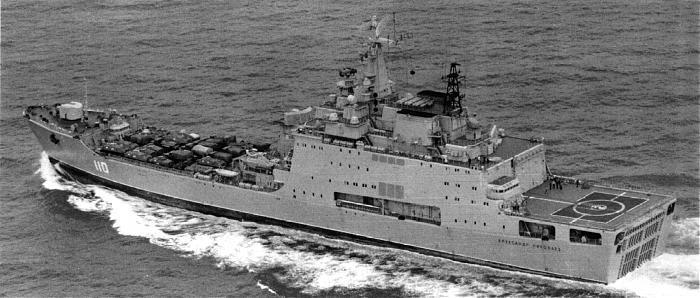
There are three versions of these Project 775 ships but they are essentially the same with minor differences in armaments and electronics. They all have both a bow ramp and stern door and are designed as RO-RO (Roll on – Roll off) ships, theoretically they can be connected to form a causeway when unloading onto the beach. 28 were built in Poland for Soviet use, with one being exported to Yemen, the remainder are in service with the various Soviet Fleets.
They are designed to deliver the better part of a Naval Infantry battalion directly onto the beach, and in that configuration they carry 340 troops and 10 MBT; or the tanks can be switched out for 12 BTRs or other combinations of tanks, APCs, armored vehicles and trucks. Alternatively, BTRs and PT-76 light tanks (mostly retired by Northern Fury) can swim out of the bow doors and on to the beach. They can also be configured to carry 500 tons of cargo directly to the beach.
| Class | Pennant | Name | Fleet | Status |
|---|---|---|---|---|
| Ropucha (Pr 775) | 134 | SDK-47 | Baltic | |
| 061 | SDK-48 | Pacific | ||
| 088 | SDK-63 | Pacific | ||
| 058 | SDK-90 | Pacific | ||
| 025 | SDK-91 | Northern | ||
| 083 | SDK-181 | Pacific | ||
| 040 | SDK-182 | Northern | ||
| 035 | SDK-183 | Northern | ||
| 093 | SDK-197 | Pacific | ||
| 011 | SDK-200 | Northern | ||
| 014 | SDK-55 | Northern | ||
| 116 | SDK-119 | Sold to Yemen | ||
| Ropucha (Pr 775/II) | 108 | BDK-14 | Pacific | |
| 086 | BDK-101 | Pacific | ||
| 125 | BDK-105 | Baltic | ||
| 058 | BDK-98 | Pacific | ||
| 039 | BDK-32 | Northern | ||
| 127 | BDK-43 | Baltic | ||
| 102 | BDK-58 | Baltic | ||
| 036 | BDK-45 | Northern | ||
| 154 | BDK-56 | Black Sea | ||
| 110 | Alexandr Shabalin | Baltic | ||
| 158 | Tsezar Kunikov | Black Sea | ||
| 142 | BDK-46 | Black Sea | ||
| 156 | BDK-67 | Black Sea | ||
| Ropucha II(Pr 775/III) | 151 | BDK-54 | Black Sea | |
| 077 | BDK-11 | Pacific | ||
| 130 | BDK-61 | Baltic |
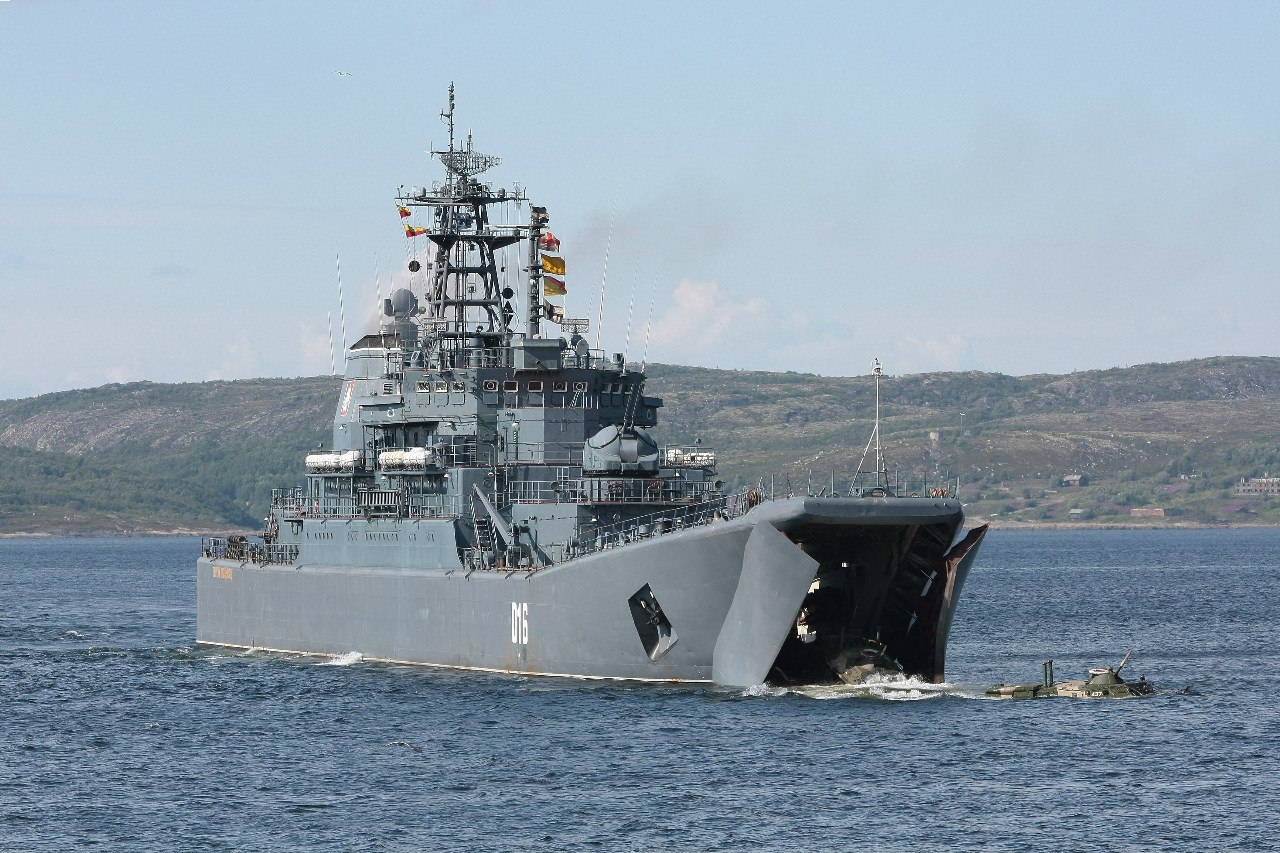
Alligator Class (Large Landing Ship)
These Project 1171 ships were built in four minor sub-classes which are all essentially the same but with different engine and mechanical systems and some variation in defensive armament. In total 15 units were built and it seems that they were designed to do the heavy lifting in an amphibious assault. They were probably paired with a Ropucha class to lift a Naval Infantry battalion as they can carry up to 20 MBT or up to 47 BTR type armored vehicles or about 50 trucks. They can also carry between 3-400 troops in various configurations which combined with a Ropucha would work out to a reinforced battalion, however some sources state that the accommodation was more rudimentary. Like a Ropucha these ships can either land directly on the beach or have amphibious vehicles swim from their open bow doors.
| Class | Pennant | Name | Fleet | Status |
|---|---|---|---|---|
| Alligator | 150 | BDK-10 | Black Sea | |
| 144 | BDK-6 | Black Sea | ||
| 093 | BDK-13 | Pacific | ||
| 023 | BDK-62 | Northern | ||
| 085 | BDK-66 | Pacific | ||
| 178 | BDK-69 | Black Sea | ||
| 099 | BDK-77 | Pacific | ||
| 119 | Donetckiy shakhter | Baltic | ||
| 115 | BDK-100 | Baltic | ||
| 146 | BDK-104 | Black Sea | ||
| 062 | Alexandr Tortcev | Pacific | ||
| 473 | Petr Ilyichev | Northern | ||
| 081 | Nikolay Vilkov | Pacific | ||
| 152 | Nikolay Filchenkov | Black Sea | ||
| 159 | Nikolay Golubkov | Northern |
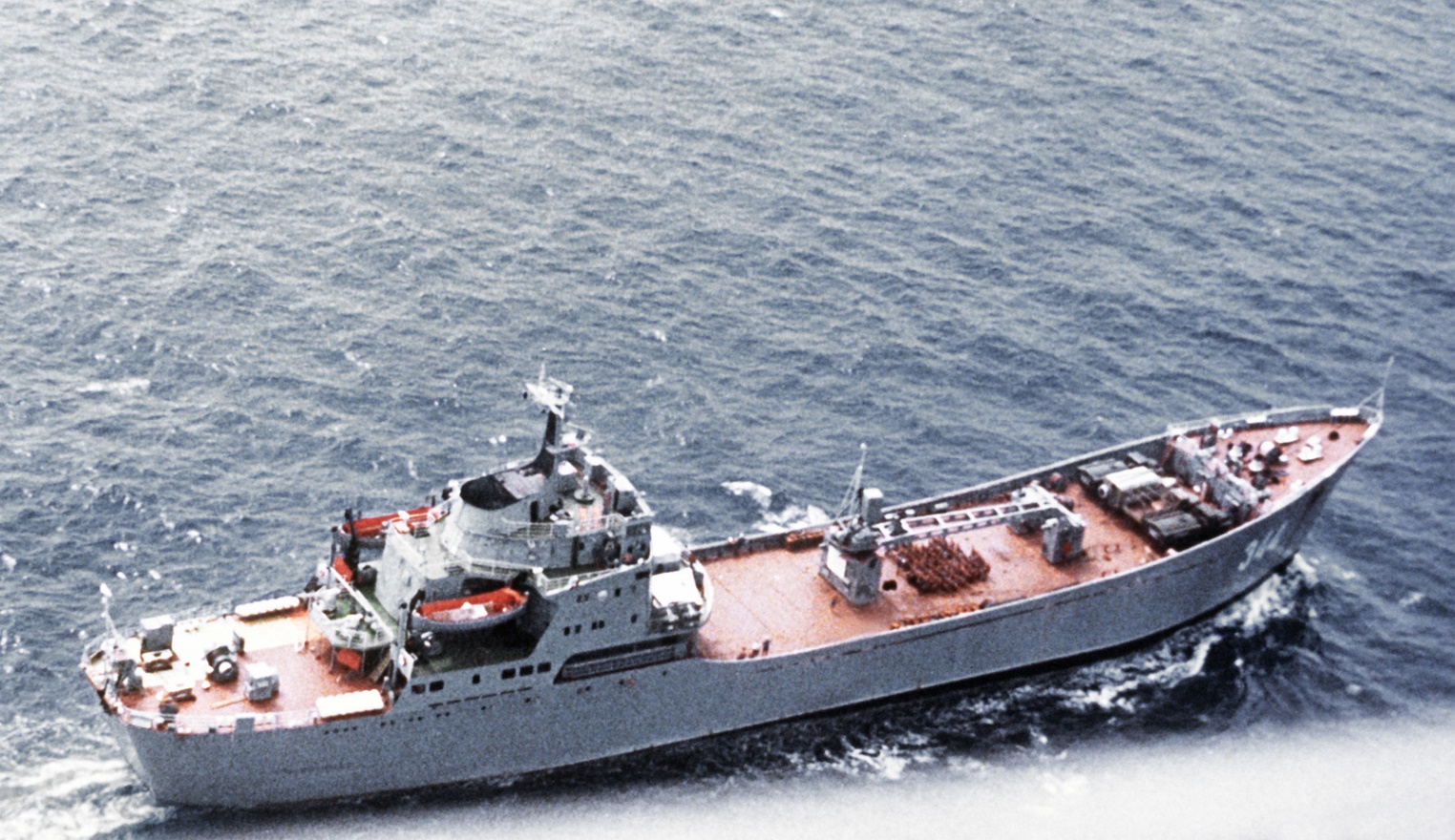
Polnocny Class (Medium Landing Ship) Project 770, 771, and 773
These medium landing ships are deployed in large numbers, 68 for the Soviets alone. All were built in Poland and are equipped with a bow ramp for beach landing, they come in three main sub-classes:
Polnocny A: With four minor variations there were 35 of these built for the Soviets, Poland also built ten for themselves. These ships can carry four or five MBT several more armored vehicles and about 200 troops. Exports included Bulgaria (2), Egypt (3), India (2), Indonesia (1), Syria (3), Somalia (1), and Yemen (3); leaving 20 serving in the various Soviet fleets. Historically some of these were retired in the early 1990s but are still active in Northern Fury.
Polnocny B: With two main variations, there were 25 built for the Soviets, Poland also had 11 of them. These ships can carry six MBT several more armored vehicles and about 200 troops. Exports included five built for Cuba (2) and Viet Nam (3) plus five transferred from Soviet fleets to Angola (3), and Ethiopia (2). Therefore leaving 20 serving in the various Soviet fleets. Historically some of these were retired in the early 1990s but are still active in Northern Fury.
Polnocny C: There were 24 of these built, eight for the Soviets, eight more for India and four each for Iraq and Lybia. These ships can carry six MBT several more armored vehicles and about 200 troops. Historically some of these were retired in the early 1990s but are still active in Northern Fury.
| Class | Northern | Pacific | Baltic | Black Sea | Remarks |
|---|---|---|---|---|---|
| Polnocny-A (Pr 770) | 8 | 12 | |||
| Polnocny-B (Pr 771) | 2 | 10 | 4 | 4 | |
| Polnocny-C (Pr 773) | 1 | 2 | 5 |
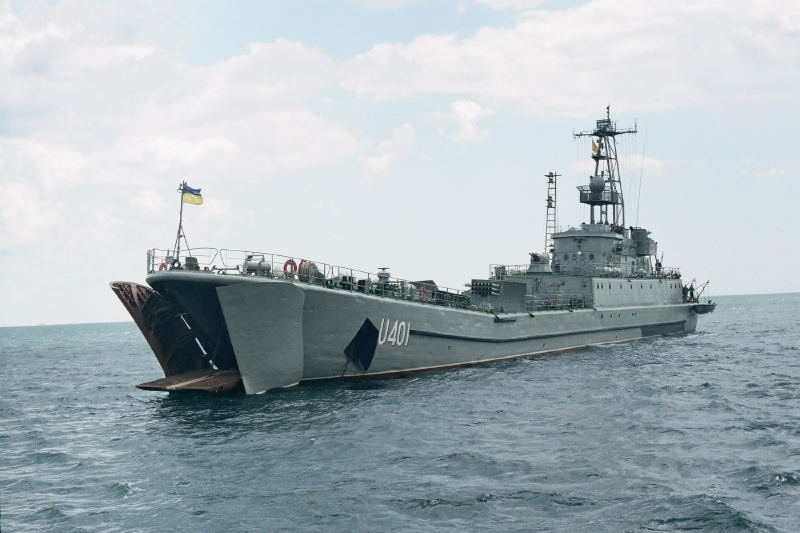
Landing Craft: Small beach landing craft which are capable of short-to-shore transport over short distances or ship-to-shore from an amphibious ship. These are generally of a traditional design similar to and in some cases copies of World War Two designs; they generally carry one or two vehicles up to MBT size and varying number of troops with very little shelter.
These small landing craft can carry one MBT or two trucks and about 20 troops. In all 36 were built in time for Northern Fury and one can be carried on the Ivan Rogov class ships.

The Vydra class can carry two, perhaps three MBT or other vehicles or up to 100 troops under some cover. The Soviet navy operates 56 of this class and the Bulgarian navy has 11 more.
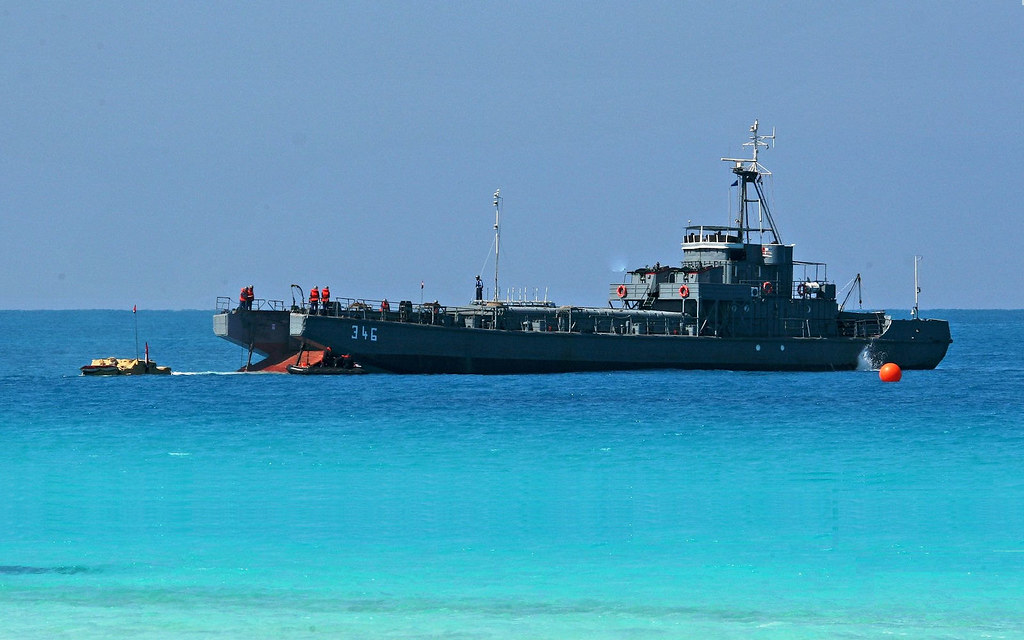
Other: there are several classes of older landing craft, mostly the Project 306, 450, 1785, and T-4, many have been scrapped or converted into tugs, lightships, service ships and other - but an estimate of about 100 remain in service.
| Class | Northern | Pacific | Baltic | Black Sea | Remarks |
|---|---|---|---|---|---|
| Polnocny-A (Pr 770) | 8 | 12 | |||
| Polnocny-B (Pr 771) | 2 | 10 | 4 | 4 | |
| Polnocny-C (Pr 773) | 1 | 2 | 5 |
Landing Craft Air Cushioned (LCAC): The Soviet navy was a pioneer in this field and placed significant priority on the development of these craft. The main advantage is speed which enhances surprise and limits the time troops are vulnerable but also this type generally avoids sea mines, can use more rugged coastline and is suitable for shore-to-shore transport of troops. The main disadvantage is fuel use so operations must be planned carefully.
Gus Class Assault Landing Hovercraft (Project 1205): A small troop-carrying hovercraft with a limited range of 200 nautical miles traveling between 43 and 50 Knots. The capacity varies based on the range that needs to be achieved but is between 25 and 50 assault troops, the can also carry 4 tons of cargo. In all there were 29 units (some sources say 32) of this class built before production turned to the Lebed class. Three of these can be carried on the Ivan Rogov class ships.
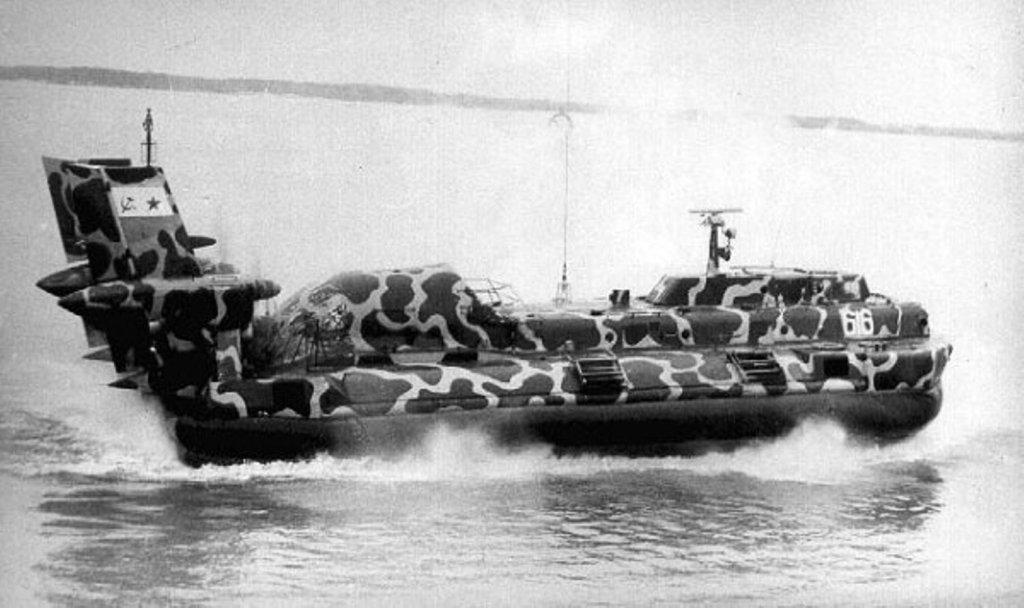
Lebed Class Air Cushion landing craft (Project 1206): Four times the displacement of the Gus Class, the 20 units built for the Soviet Navy are similar to the US Navy’s LCAC but were in service well before it was adopted. They can each carry 1 MBT or 2 armored vehicles or 120 troops or 37 tons of cargo – but only to a range of 100 nautical mines at 50 Knots. Two can be carried on the Ivan Rogov class ships.
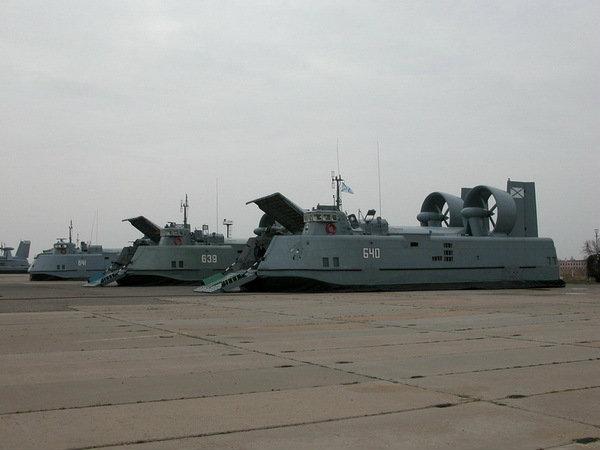
Tsaplya Class Air cushion landing craft (Project 12061): A lengthened version of the Lebed Class, 12 units were completed (as planned, construction of the last two was not terminated) and can carry 1 MBT or 2-3 armored vehicles or 130 troops or 42 tons of cargo. All are in the Pacific Fleet and focused on the Amer River border with China.
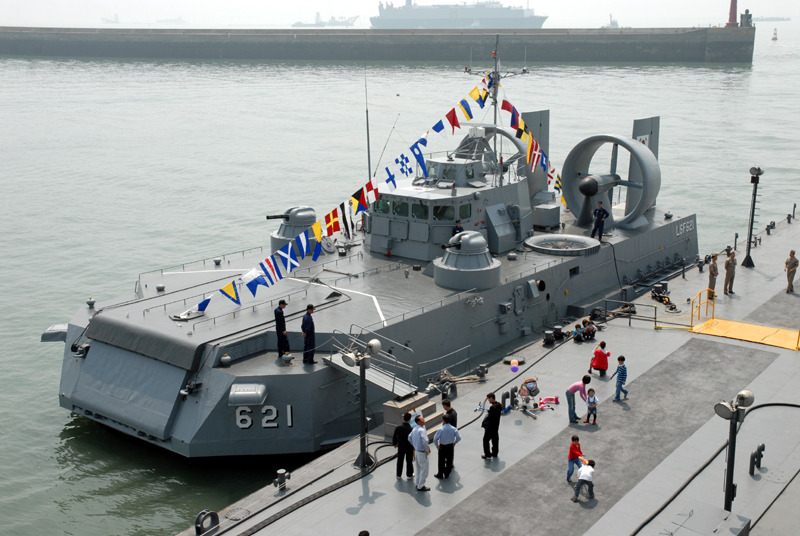
Utenok Class Air Cushion Landing Assault Boat (Project 1209) These two assault hovercraft were used in the Baltic fleet and carry 60 troops or 6 tons of cargo at a speed of 60 knots to a range of 200 nautical miles. These were probably designed to provide high speed troop lift in accompaniment for the Lebed class.
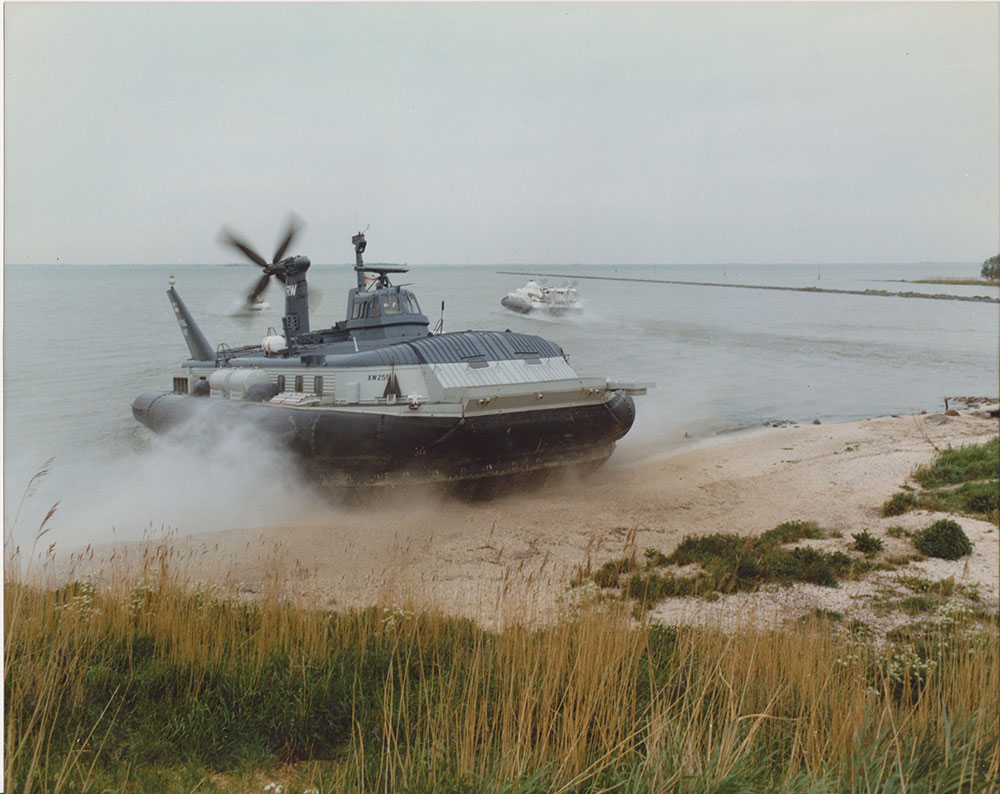
Aist Class Small Air Cushion Landing Ships (Project 12321): Considered ships and not craft, the descriptor of ‘small’ is somewhat misleading. Although the number built is often 20, they were historically in serial production so in Northern Fury there are 24 available. The Aist class can carry two T-72 type MBT or 4-5 armored vehicles or 80 troops or 73 tons of cargo and have a range of 120 nautical miles at a speed of 50 knots, although they can travel at 70 knots if needed this reduces their range significantly.
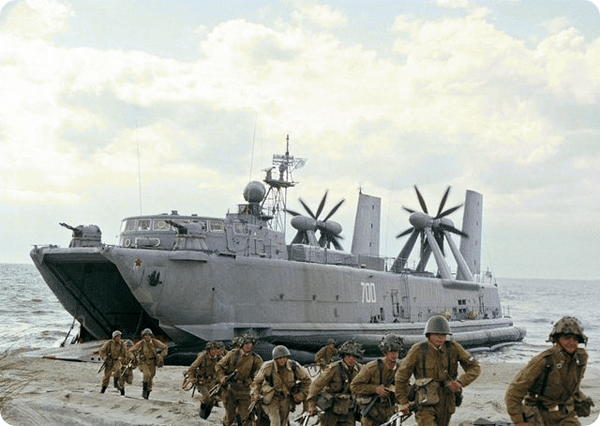
Zubr Class Small Air Cushion Landing Ships (Project 12322): These are the worlds largest hovercraft with a displacement of over 550 tons In Northern Fury all that were under construction have been completed for a total of 14 now available. These ships essentially carry a company of Naval infantry (10 x APC and 120 troops) or a troop of tanks with a capacity of three MBT or 8-10 armored vehicles or 360 troops or 150 tons of cargo. The range is 300 nautical miles at 55 knots although its top speed is 63 knots.
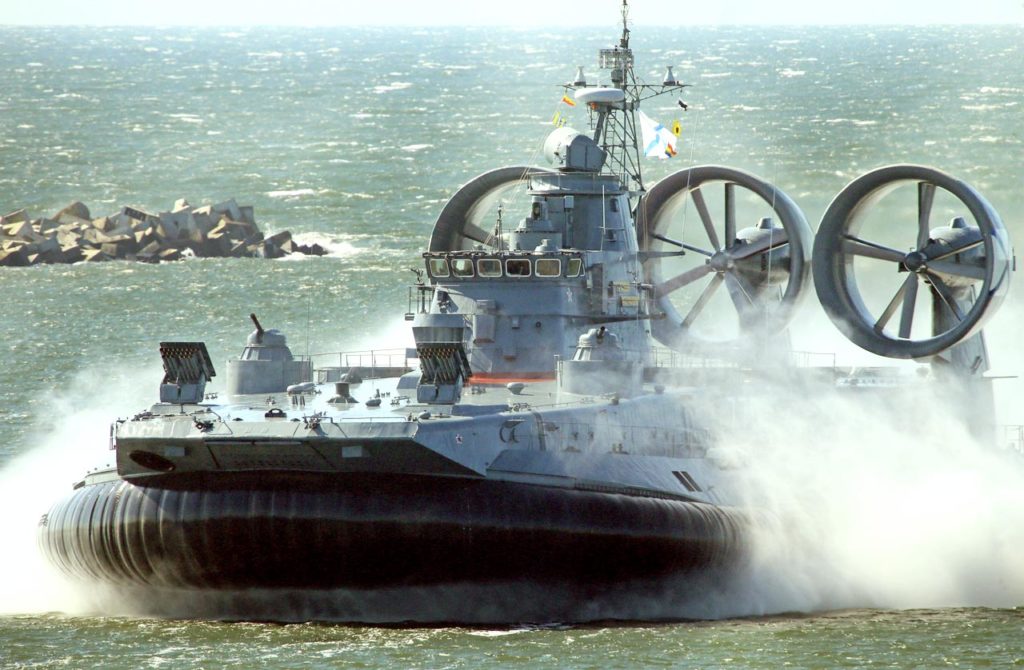
| Class | Northern | Pacific | Baltic | Black Sea | Remarks |
|---|---|---|---|---|---|
| Gus (Pr 1205) | 13 | 8 | 8 | ||
| Lebed (Pr 1206) | 7 | 8 | 5 | ||
| Tsaplya (Pr 12061) | 12 | ||||
| Utenok (Pr 1209) | 2 | ||||
| Aist (Pr 12321) | 16 | 8 | |||
| Zubr (Pr 12322) | 2 | 2 | 7 | 3 |
Civilian ships: The Soviet Navy does not have enough amphibious lift to follow up its NI forces with heavier ground forces so it needs to use civilian shipping. Nationalizing civilian shipping should not be an issue as there are more than 1,000 ships available for use as military support, many will be at sea or unavailable in time of war but sufficient will be ready to assist military forces. Key amongst these ships are:
- Two (2) SeaBee barge carriers built by Finland in the late 1970s. The same Lighter Aboard Ship (LASH) system is used by the US Navy and the original designs were purchased from the US. These two ships; the Yulius Fuchik and Tibor Szamueli each carried 26 Lighters (barges) each displacing 1,300 tons, an additional 56 LASH barges, two pusher tugs and 1,552 standard shipping containers. The ships were also configured for RO-RO (Roll on – Roll off) operations similar to ferries. Each of these ships can lift the equipment of a standard Motor Rifle Regiment (MRR) or Tank Regiment (TR) and other supplies and equipment.
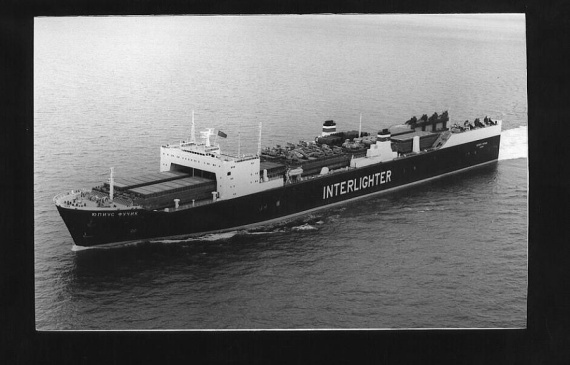
- Thirty (30) RO-RO ships. These ships are critical for rapid unloading in a beachhead area, they require some form of pier, or ferry dock to unload but can probably unload onto the rear of a Ropucha class for ship allowing the vehicles to drive through that ship onto a causeway or beach. It would take 3-4 of these ships to transport a MRR or TR.
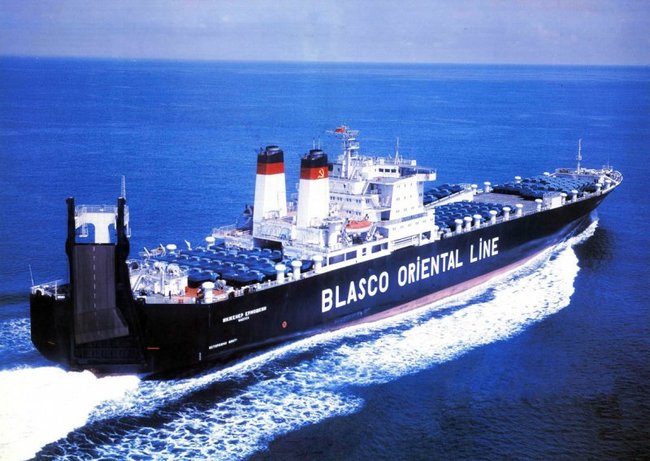
- Seventy (70) passenger ships with a capacity to carry 150-200,000 troops under wartime conditions. To transport an MRR with about 2,500 troops, one or two large passenger ferries or small liners would likely be sufficient over short distances.
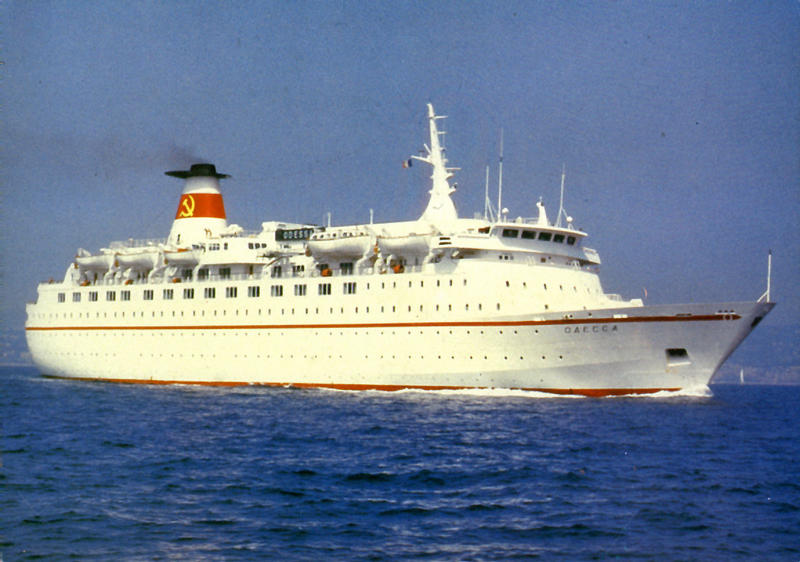
- Six hundred (600) ships with heavy lift booms capable of lifting more than 40 tons. These ships are both self unloading but can also assist other ships in unloading in a small port, providing there is a pier available. These can also be augmented for speedier unloading by using port infrastructure but having ships that can self unload provides significant flexibility to the amphibious force.
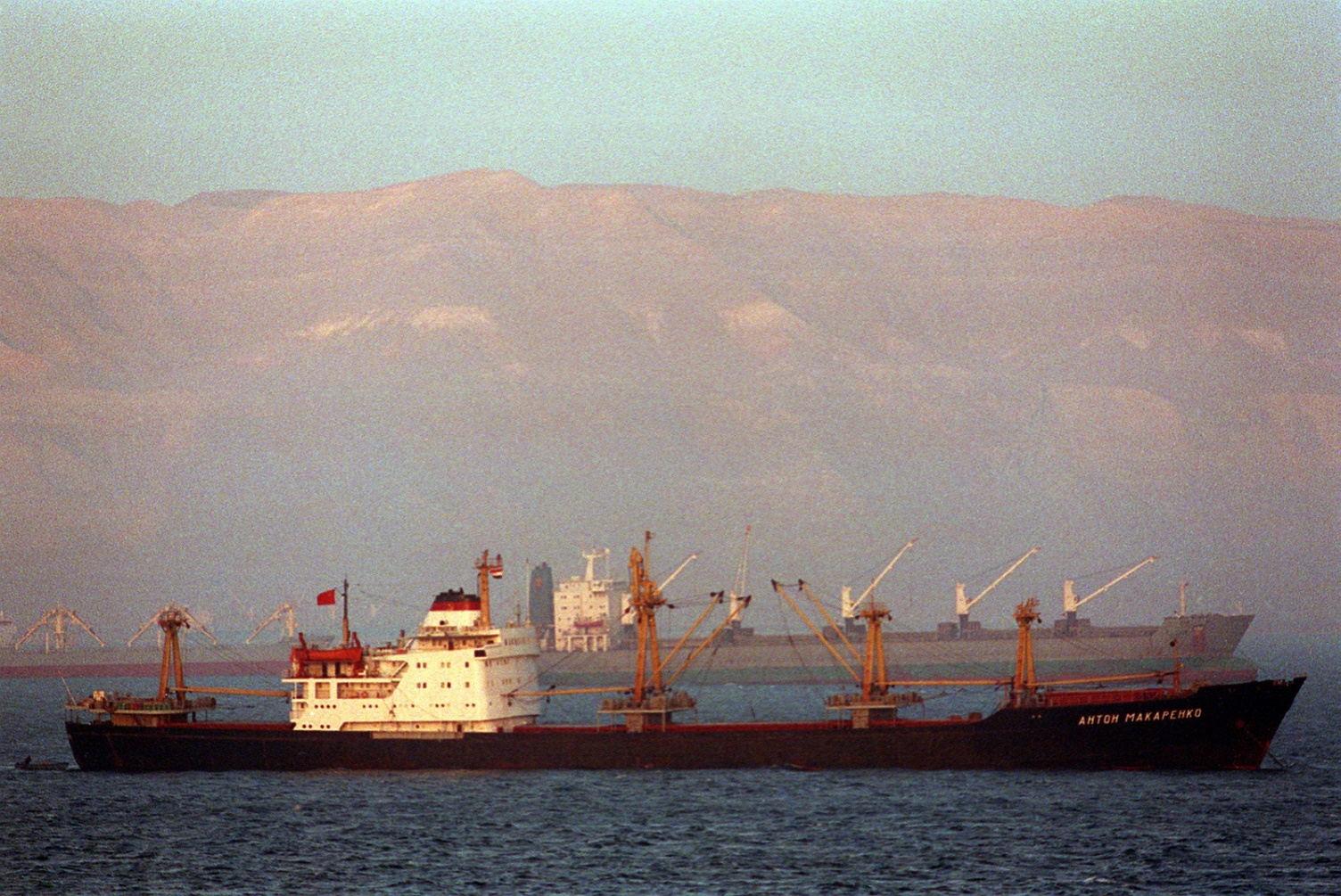
- Six hundred (600) cargo ships with the speed, capacity and range to be useful for amphibious or support operations. Many have cranes but less than 40 ton capacity.
